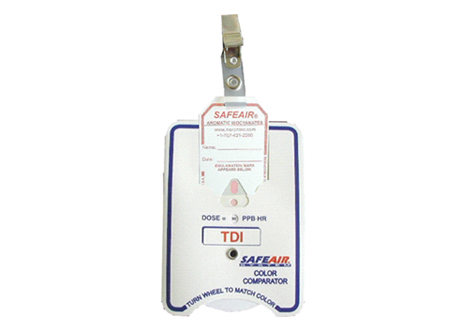Description
Safeair isocyanate badges is a dual reading badge for Toluene Disocyanate (TDI) & Methyl Diphenyl Diisocyanate (MDI). This badge provides an immediate visual indication to warn the badge wearer of excessive toxic gas or isocyanate exposure levels. This makes it ideal for personal exposure limits monitoring for exposure times ranging from 15 minutes to 24 hours.
• Easy to use
• Highly sensitive and selective
• Ideal for daily employee screening or gas detection
• No calibration or laboratory analysis needed
SAVE Money – Buy the Safeair System Starter Kit to make a cost saving on 10 dual isocyanate badges, a TDI colour comparison chart and 10 strap clips
TDI monitoring
When monitoring TDI, the SafeAir aromatic isocyanates badge may be used in conjunction with the SafeAir TDI colour comparison chart (383005). Items sold separately. For exposure times less than 30 minutes, it is recommended to allow the exposed badge to stand for at least 30 minutes before reading the exposure dose with the colour comparator. Do not attempt to use the TDI colour comparator when measuring MDI, instead, you need to calculate the concentration as explained below.
MDI Badge Colour Change and Calculation Explained
“When using the SafeAir aromatic isocyanates badge for the monitoring of MDI, since we don’t offer a colour comparator for MDI, it is a yes/no result badge. The sensitivity to the badge is 3.5ppb.hr. When opening the badge, the entire triangle including the exclamation mark will be off-white. Once the exclamation mark changes colour, (this will be a pink or red colour change), the wearer is at or above the sensitivity of the badge.
To determine the average concentration, you would take the sensitivity of the badge and divide it by the time it took for the badge to change colour. (So let’s say for example the badge changed colour within 4 hours, you would take the 3.5ppb.hr and divide by 4 for the average concentration of at least 0.875ppb). If the colour change occurs sooner, the concentration would have been higher, e.g. a colour change after 2 hours would have been caused by a concentration of at least 1.75ppb MDI. We suggest checking the badge frequently, more so in the beginning, because the faster the badge changes colour the higher the concentration”
Operating Instructions
1. Remove the pouch from the refrigerator and allow it to warm to room temperature.
2. Remove the badge from its protective pouch.
3. For personnel monitoring, attach the badge near the user’s breathing zone (i.e. the collar) with the front side exposed to the surrounding atmosphere.
4. For area monitoring, attach the badge to a stand and mount in a centralised area with the front side exposed to the surrounding atmosphere.
5. The exclamation mark appears within the triangle when TDI and/or MDI are present. Please note that the exclamation mark will appear on the front of the badge.
6. To obtain the average concentration, divide the exposure dose (ppb·hr) by the exposure time in hours (hr).
For more information, download the datasheet
Additional Information
| Weight | 0.15 kg |
|---|---|
| Multi Gas Tags | |
| Brand | |
| Configuration |
Talk with the Experts
Contact us - Our team of application specialists can assist you with system design, installation, maintenance, and repair. As a systems integrator, we provide end-to-end support to ensure your facility has a reliable and effective gas detection system in place.
Sign up for more information - For more information on protecting your staff from the dangers of gas leaks, sign up for our emails.














